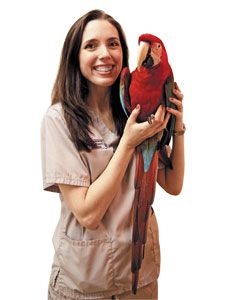The exotic pet technician's role: Why specializing matters
Here's a glimpse into the job of a veterinary technician who specializes in exotic companion animals.

Everyone knows that chocolate and Lilies can kill cats, but did you know overheating non-stick cookware can kill a bird? Each exotic species has unique traits. This can make working with exotics a challenging—and amazing—job.
We've watched technicians' roles grow beyond assisting veterinarians to include discussing treatment plans and payment options, placing catheters, collecting samples, administering medication, monitoring surgical patients, positioning patients for radiology and communicating with clients constantly. This can be taxing on the most qualified dog and cat technician. And imagine that instead of just two species, there were many more species that required these services, each with dramatically different anatomy, physiology and medical needs. Sounds hard, right? And maybe a little exciting, too? Here's a glimpse into the job of a technician who specializes in exotic companion animals.
Everyday exotics
Inpatients are the first focus of the day. And as with most dog and cat technicians, exotic technicians begin by observing overnight production, obtaining temperature, pulse, and respiration, and getting morning treatments ready. But this is where the similarities end. Exotic technicians must know what’s normal for a huge variety of animals. For instance, is it normal that a snake doesn’t defecate overnight? What about a chinchilla? How do you determine a pain scale for a parrot? What would be normal body temperature for a ferret vs. a rabbit?
Nursing instructions are also incredibly varied. Exotics technicians must understand the extreme gentleness required to restrain and medicate a scared rabbit who could severely injure itself if not handled properly. They must be ready to navigate exactly how they are going to get a large, aggressive cockatoo restrained safely, and then administer subcutaneous fluids. Many of the doctors orders may appear the same as they would for a dog or cat practice. However getting these medications into exotic pets requires a completely different set of skills and training.
Appointments for exotic pets are very different from dog and cat appointments. Exotic technicians spend much of their day explaining the complicated care required to keep these unique animals healthy. We’re fighting a battle against the terrible products and diets clients are often sold at pet stores that are outdated and not correct for the requirements of the species. We fight against the frustrating misinformation on the Internet, where so many exotic pet owners go before actually coming to the veterinarian. And we are fighting the disturbing fact that many of our patients are considered disposable caged pets, and aren’t valued the same way as a beloved family dog.
Caring for unusual pets
Once we finish what's often 30 to 40 minutes of discussion fixing the nutrition and husbandry issues usually present, technicians must do the technical work we’re trained for. However, the challenges with exotic pets are huge. Where exactly do you take blood from a box turtle that’s completely housed inside its shell? How will you obtain that culture from the mouth of a balled-up hedgehog? And there's little room for mistake. You get one chance to take a blood sample from a parakeet, andyes, sometimes a simple routine blood draw can result in death. There's a lot more chance things can go wrong in the hands of an inexperienced technician when dealing with these animals.
Clients are becoming more savvy, and they want to know their pets are receiving specialized care. We owe it to the animals to give them the opportunity to have the most highly qualified technicians working on them. As with doctors specializing in exotic pet medicine and surgery, technicians now too have a specialty of our own. This elevates the level of care we provide, and maintains high standards in our profession we can all be proud of.
Lorelei Tibbetts, LVT, VTS (Clinical Practice—Exotic Companion Animal), is practice manager and director of nursing at The Center for Avian and Exotic Medicine in New York City.